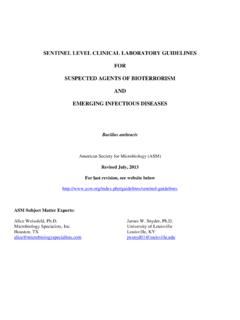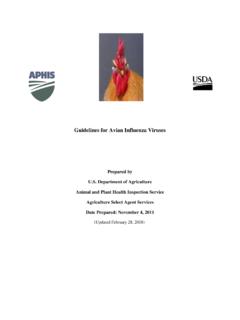Transcription of Section VIII-G: Toxin Agents
1 268 biosafety in Microbiological and Biomedical LaboratoriesSection viii -G: Toxin AgentsBotulinum NeurotoxinSeven immunologically distinct serotypes of Botulinum neurotoxin (BoNT) have been isolated (A, B, C1, D, E, F and G). Each BoNT holotoxin is a disulfide-bonded heterodimer composed of a zinc metallo-protease light chain (approximately 50 kD) and a receptor binding heavy chain (approximately 100 kD). The heavy chain enhances cell binding and translocation of the catalytic light chain across the vesicular There are also a number of important accessory proteins that can stabilize the natural Toxin complex in biological systems or in of the serotypes (A, B, E and, less commonly, F) are responsible for most human poisoning through contaminated food, wound infection, or infant botulism, whereas livestock may be at greater risk for poisoning with serotypes B, C1 and ,3 It is important to recognize, however, that all BoNT serotypes are highly toxic and lethal by injection or aerosol delivery.
2 BoNT is one of the most toxic proteins known; absorption of less than one microgram ( g) of BoNT can cause severe incapacitation or death, depending upon the serotype and the route of of Laboratory ExposuresBotulism is primarily clinically diagnosed through physician observations of signs and symptoms that are similar for all serotypes and all routes of There typically is a latency of several hours to days, depending upon the amount of Toxin absorbed, before the signs and symptoms of BoNT poisoning occur. The first symptoms of exposure generally include blurred vision, dry mouth and difficulty swallowing and speaking. This is followed by a descending, symmetrical flaccid paralysis, which can progress to generalized muscle weakness and respiratory failure. Sophisticated tests such as nerve conduction studies and single-fiber electromyography can support the diagnosis and distinguish it from similar neuromuscular conditions.
3 Routine laboratory tests are of limited value because of the low levels of BoNT required to intoxicate, as well as the delay in onset of Safety and Containment RecommendationsSolutions of sodium hypochlorite ( ) or sodium hydroxide ( ) readily inactivate the Toxin and are recommended for decontamination of work surfaces and for spills. Additional considerations for the safe use and inactivation of toxins of biological origin are found in Appendix I. Because neurotoxin producing Clostridia species requires an anaerobic environment for growth and it is essentially not transmissible among individuals, exposure to pre-formed BoNT is the primary concern for laboratory workers. Two of the most significant hazards in working with BoNT or growing neurotoxin producing Clostridia species cultures are unintentional aerosol generation, especially during centrifugation, and accidental needle-stick. Although BoNT does not penetrate intact skin, agent Summary Statements: Toxin Agents 269proteins can be absorbed through broken or lacerated skin and, therefore, BoNT samples or contaminated material should be handled with in diagnostic laboratories should be aware that neurotoxin producing Clostridia species or its spores can be stable for weeks or longer in a variety of food products, clinical samples ( , serum, feces) and environmental samples ( , soil).
4 Stability of the Toxin itself will depend upon the sterility, temperature, pH and ionic strength of the sample matrix, but useful comparative data are available from the food industry. BoNT retains its activity for long periods (at least 6-12 months) in a variety of frozen foods, especially under acidic conditions (pH ) and/or high ionic strength, but the Toxin is readily inactivated by documented incident of laboratory intoxication with BoNT occurred in workers who were performing necropsies on animals that had been exposed 24 h earlier to aerosolized BoNT serotype A; the laboratory workers presumably inhaled aerosols generated from the animal fur. The intoxications were relatively mild, and all affected individuals recovered after a week of Despite the low incidence of laboratory-associated botulism, the remarkable toxicity of BoNT necessitates that laboratory workers exercise caution during all experimental practices, containment equipment, and facilities are recommended for routine dilutions, titrations or diagnostic studies with materials known to contain or have the potential to contain BoNT.
5 Additional primary containment and personnel precautions, such as those recommended for BSL-3, should be implemented for activities with a high potential for aerosol or droplet production, or for those requiring routine handling of larger quantities of not directly involved in laboratory studies involving botulinum Toxin , such as maintenance personnel, should be discouraged from entering the laboratory when BoNT is in use until after the Toxin and all work surfaces have been decontaminated. Purified preparations of Toxin components, isolated BoNT light chains or heavy chains, should be handled as if contaminated with holotoxin unless proven otherwise by toxicity IssuesVaccines A pentavalent (A, B, C, D and E) botulinum toxoid vaccine (PBT) is available through the CDC as an IND. Vaccination is recommended for all personnel working in direct contact with cultures of neurotoxin producing Clostridia species or stock solutions of BoNT.
6 Due to a possible decline in the immunogenicity of available PBT stocks for some Toxin serotypes, the immunization schedule for the PBT recently has been modified to require injections at 0, 2, 12, and 24 weeks, followed by a booster at 12 months and annual boosters thereafter. Since there is a possible decline in vaccine efficacy, the current vaccine contains toxoid for only 5 of the 7 Toxin types, this vaccine should not be considered as the sole means of protection and should not replace other worker protection biosafety in Microbiological and Biomedical LaboratoriesSelect agent Botulinum Toxin is a select agent requiring registration with CDC and/or USDA for possession, use, storage and/or transfer if quantities are above the minimum exemption level. See Appendix F for additional of agent Importation of this agent may require CDC and/or USDA importation permits. Domestic transport of this agent may require a permit from USDA/APHIS/VS.
7 A DoC permit may be required for the export of this agent to another country. See Appendix C for additional Enterotoxins (SE)SE are a group of closely related extracellular protein toxins of 23 to 29 kD molecular weight that are produced by distinct gene clusters found in a wide variety of S. aureus ,9 SE belong to a large family of homologous pyrogenic exotoxins from staphylococci, streptococci and mycoplasma which are capable of causing a range of illnesses in man through pathological amplification of the normal T-cell receptor response, cytokine/lymphokine release, immunosuppression and endotoxic ,10SE serotype A (SEA) is a common cause of severe gastroenteritis in It has been estimated from accidental food poisoning that exposure to as little as to 1 g SEA by the gastric route causes incapacitating Comparative human toxicity for different serotypes of SE is largely unknown, but human volunteers exposed to 20-25 g SE serotype B (SEB) in distilled water experienced enteritis similar to that caused by are highly toxic by intravenous and inhalation routes of exposure.
8 By inference from accidental exposure of laboratory workers and controlled experiments with NHP, it has been estimated that inhalation of less than 1 ng/kg SEB can incapacitate more than 50% of exposed humans, and that the inhalation LD50 in humans may be as low as 20 ng/kg of mucous membranes to SE in a laboratory setting has been reported to cause incapacitating gastrointestinal symptoms, conjunctivitis and localized cutaneous of Laboratory ExposuresDiagnosis of SE intoxication is based on clinical and epidemiologic features. Gastric intoxication with SE begins rapidly after exposure (1-4 h) and is characterized by severe vomiting, sometimes accompanied by diarrhea, but without a high fever. At higher exposure levels, intoxication progresses to hypovolemia, dehydration, vasodilatation in the kidneys, and lethal agent Summary Statements: Toxin Agents 271 While fever is uncommon after oral ingestion, inhalation of SE causes a marked fever and respiratory distress.
9 Inhalation of SEB causes a severe, incapacitating illness of rapid onset (3-4 h) lasting 3 to 4 days characterized by high fever, headache, and a nonproductive cough; swallowing small amounts of SE during an inhalation exposure may result in gastric symptoms as diagnosis of SE inhalation may be unclear initially because the symptoms are similar to those caused by several respiratory pathogens such as influenza, adenovirus, and mycoplasma. Naturally occurring pneumonias or influenza, however, would typically involve patients presenting over a more prolonged interval of time, whereas SE intoxication tends to plateau rapidly, within a few hours. Nonspecific laboratory findings of SE inhalation include a neutrophilic leukocytosis, an elevated erythrocyte sedimentation rate, and chest X-ray abnormalities consistent with pulmonary confirmation of intoxication includes SE detection by immunoassay of environmental and clinical samples, and gene amplification to detect staphylococcal genes in environmental samples.
10 SE may be undetectable in the serum at the time symptoms occur; nevertheless, a serum specimen should be drawn as early as possible after exposure. Data from animal studies suggest the presence of SE in the serum or urine is transient. Respiratory secretions and nasal swabs may demonstrate the Toxin early (within 24 h of inhalation exposure). Evaluation of neutralizing antibody titers in acute and convalescent sera of exposed individuals can be undertaken, but may yield false positives resulting from pre-existing antibodies produced in response to natural SE Safety and Containment RecommendationsGeneral considerations for the safe use and inactivation of toxins of biological origin are found in Appendix I. Accidental ingestion, parenteral inoculation, and droplet or aerosol exposure of mucous membranes are believed to be the primary hazards of SE for laboratory and animal-care personnel. SE are relatively stable, monomeric proteins, readily soluble in water, and resistant to proteolytic degradation and temperature fluctuations.














